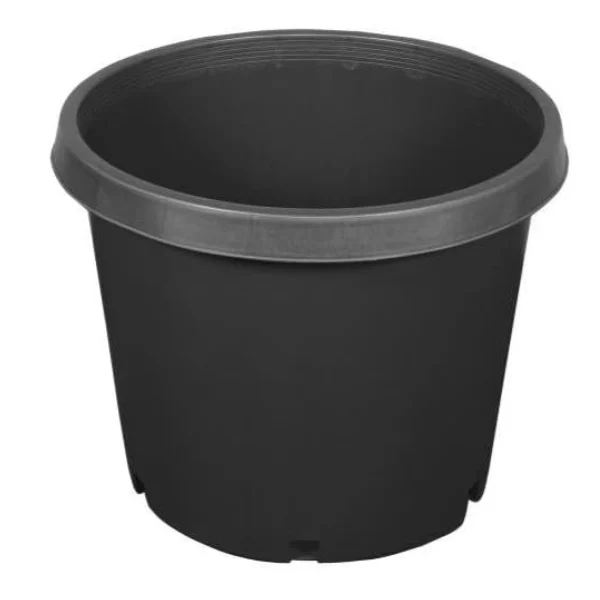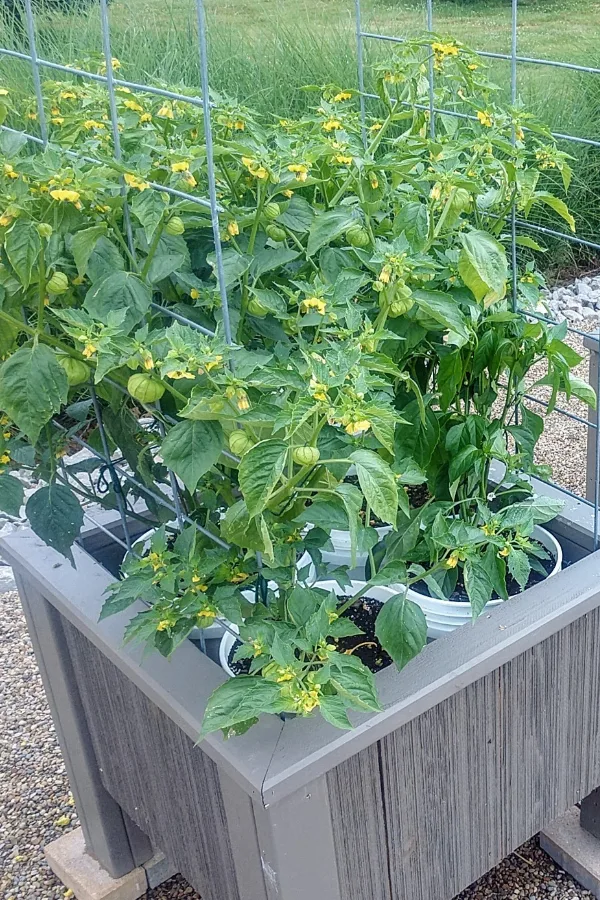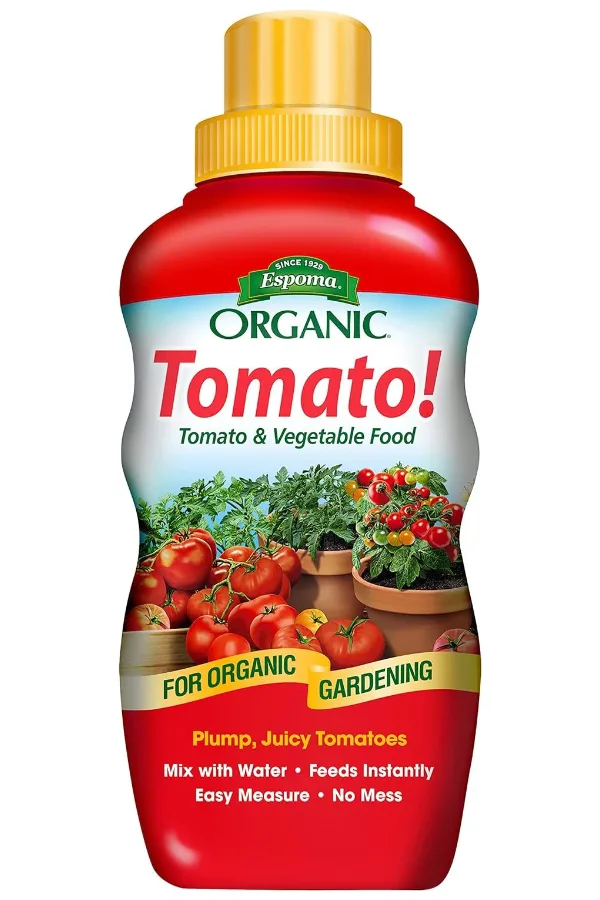If you want to grow your own tomatoes but don’t have enough space in your backyard for a little garden – you need to try your hand at growing tomatoes in 5 gallon buckets or large containers. Not only is it easy to do, it lets you grow amazing tomatoes almost anywhere – with ease!
Believe it or not, there are actually quite a few advantages to growing tomato plants in containers. For starters, it allows you to give them the rich, fertile, well draining soil they need for strong growth. That can often be a challenge if you happen to live in an area where soil is less than ideal for growing.
Growing in containers also eliminates many of the difficult chores of a traditional garden. There is no need to till or prepare garden soil, nor do you have to spend countless hours having to weed your plants.

Even better, growing in a container or a 5 gallon bucket lets you put your plants in the best possible position for success. Tomato plants need a lot of sunlight to grow and produce. In a container, it’s easy to place it where your plants can get full sun – whether that be on a sunny patio, deck, rooftop – or even in your driveway.
But perhaps the best news of all is that as long as you have a 5 gallon bucket or large enough container, you can grow nearly any tomato variety you want. Even the large beefsteak and slicing varieties that are perfect for topping the largest of hamburgers or sandwiches!
How To Grow Tomatoes In Buckets & Containers – The 4 Simple Steps To Success
When growing in containers, there are really 4 big keys to getting plants to produce a sizable harvest:
- Selecting the right size container.
- Filling it with fertile, well draining soil.
- Giving your tomato plant proper support.
- Watering & fertilizing with the right nutrients, and on a consistent basis.
Here is an in-depth look at each critical step, starting with making sure you pick the right size and type of container to grow with success.
1. Selecting The Right Size Container
Tomato plants rely on their roots to soak in the moisture and nutrients they need to grow and produce. Quite simply, the bigger the root system, the better the plant will perform. That is exactly why when growing in a container, it’s important to select a big enough vessel to allow for large roots.

One thing is for sure, when growing tomatoes, small, shallow pots and containers simply won’t work. They will become root bound too quickly, and your tomato plants will run out of available space long before they are ready to produce.
5 gallon buckets are actually perfect for growing tomatoes. The large circumference and the 14 to 16 inches of depth most buckets have allow for plenty of root growth. Large 10 to 15 gallon nursery pots (For small trees and bushes) are also an excellent choice. Affiliate Link: Gro Pro 724830 Premium 15 Gallon Plant-Nursery-pots
The key is to select pots that are deep enough and wide enough to grow extensive roots. It’s also important to make sure they can drain well. Most nursery pots already come with drain holes. For 5 gallon buckets, you can simply drill holes in the bottom to allow excess water a place to exit.
2. Filling Your Pots With Great Soil – How To Grow Tomatoes In Buckets & Containers
Now that you have a great container, it’s time to fill it with great soil! Ordinary garden soil is not a good choice when growing tomatoes in a pot. It’s simply too heavy and dense to allow for good root growth.
Listen To Our Podcast Below On How To Grow Vegetables In Buckets & Containers!
Instead, start with a good all-purpose potting soil that is light and full of nutrients. But don’t stop there. You also need to add compost and worm castings to the mix to really power up your soil. For every 6 to 8 cups of potting soil, add in 2 cups of compost and 1/2 cup of worm castings.
Compost is light and full of easy to absorb nutrients for tomato plants. It will allow roots to grow and expand quickly, all while providing a constant low and slow energy source to your plants.
Worm castings are even more powerful, not only adding energy to the soil, but also helping to keep moisture right at the roots. Together, the two additional ingredients can propel your tomato plants to amazing growth and a big harvest! Affiliate Link: WIGGLE WORM 100% Pure Organic Worm Castings, 30 Pounds
Once your soil is mixed and in place – plant your tomato plant deep in the pot. How deep? Bury the plant so that it is at least 6 inches down in the pot. This will allow the plant to develop new roots all along the main stem that is under the soil. Again, more roots mean a healthier, more productive plant!
3. Giving Your Tomato Plants Support – How To Grow Tomatoes In Buckets & Containers
Tomato plants can carry a lot of weight. Especially when they are loaded with ripening fruit. Because of this, supporting your plants as they grow is vital to keeping them upright, safe and productive.
This can be done in several ways when growing in buckets. Many gardeners use a stake buried in the bucket to tie their plants to as they grow. You can also place your buckets against a trellis or wall to provide support.

As a final option, there are also planter boxes that can hold buckets and containers along with a trellis. These can also help make growing in buckets more attractive as well. See: DIY 5 Gallon Bucket Planter Plans
Whatever you do, make sure you provide support to your tomatoes as soon as you plant. The best time to do this is right as you plant. This keeps plants safe from the start. It also avoids damaging growing roots when stakes are driven into the soil later on.
4. Watering & Fertilizing – How To Grow Tomatoes In Buckets & Containers
Last but not least, when growing tomatoes in buckets, proper watering and fertilizing are crucial to keep your plants strong and healthy.
In a container, the soil will dry out much faster than in a traditional garden setting. Your plants will likely need to be watered every day. That can often increase to twice a day (morning/evening) as they begin to fully mature.
To know when to water, always check the soil moisture down below the surface. If the soil is dry a few inches down near the root level, it’s time to water. A soil moisture meter can make this task easy. You can simply insert the probes down into the soil and get an instant reading of the moisture level. Affiliate Link: Instant Soil Moisture Meter.
One final note, when watering, always water at the surface and avoid spraying the foliage. Spraying the entire plant can promote mold and knock off blooms as well.
Fertilizing For Success
Because container tomato plants are growing in limited soil, fertilizing is a must. This keeps a steady supply of nutrients coming to the plant at all times. The key when fertilizing tomatoes in containers is to give them a consistent but lower dose of nutrients.
In place of fertilizing with a full dose every three or four weeks, give your plants a lighter dose every ten to fourteen days. To do this, you can use compost tea or worm casting tea – or mix a commercial liquid fertilizer at half strength.
Compost and worm casting tea will not burn plants and can be given at full strength. However, if using a stronger fertilizer, by mixing it at half strength, you can give it more often. This will keep the plant strong, but not cause it to overgrow its foliage at the expense of producing fruit.
Here is to growing tomatoes in buckets and containers this year with big success – anywhere! For more on selecting great types of tomatoes to grow in containers, check out our tomato variety page on the blog!
I Grow Tomatoes
Follow Our Facebook Page For Even More Great Tomato Growing Tips! I Grow Tomatoes Facebook Page
I Grow Tomatoes is a website created for those who love all things about tomatoes – from planting and growing – to cooking and canning! We publish two articles every week, 52 weeks a year. Sign up today to follow via email! This article may contain affiliate links.

